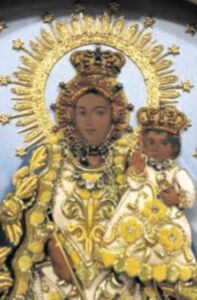The Miracle of 1854
THE HUMBLE chapel in Manila’s Barrio San Miguel, where devotees venerated an image of Nuestra Señora del Rosario, had been the only structure spared from the great fire that reduced everything around it to ashes.

By Shaymaa Khalil
THE HUMBLE chapel in Manila’s Barrio San Miguel, where devotees venerated an image of Nuestra Señora del Rosario, had been the only structure spared from the great fire that reduced everything around it to ashes.
The fire was so huge, engulfing everything in its path, that firemen attempting to turn left at the foot of Ayala Bridge had to detour. By the time they arrived at the scene, the fire had gone out. Every structure had been consumed by the fire, except for a humble visita, unscathed amid all the smoldering ruin.
Witnesses to the April 16, 1854 fire described the event as a miracle because only the bamboo and nipa chapel and its surrounding grass had been untouched by the huge fire.
To establish that the event had been a true miracle, the Archbishop of Manila, Francisco G. Ortiz, assigned the Reverend Parish Priest Domingo Azorin to investigate “so that it may be consigned to the truth by the competent authority to prevent being distorted with arbitrary and false traditions.”
Among six witnesses, Don Juan de Martin y Arevalo, Assistant to the European English Engineers, described how “It was a true miracle that the aforementioned ermita (hermitage) was saved from the fury of the flames. On the occasion of the conflagration of the house adjacent to the hamlet by the east, the direction from where the fresh wind came, the houses at the back of the ermita were also burned; that due to the intensity of the fire, it crossed the adjacent stone house of Mr. Tomas Fuentes, and it was impossible for him to go to the Quintana Bridge with the firemen that the declarant had in his charge, by which they had to go with the firemen to San Sebastian Causeway toward Malacañang, and from there to the town of San Miguel, and when they arrived, they saw that the ermita was intact and the fire had died down.”
“My house, which was burned, was eight yards from the side of the ermita or visita of Our Lady of the Rosary, and (I) saw that the flames from my house and the other houses beside the ermita were about to fall on the roof of the chapel, and some sparks of fire also died by the strong wind and indeed it is admirable to see that the ermita was saved from the fire, even if there had not been any help, for when the firemen approached the place, the fire was already extinguished. That from the day after the fire, perhaps because the news of this even had already spread, there was this sudden rush of people who gave alms and others, candles, plucking some grass in the vicinity of the visita for the medicine,” Doña Isabel Frias, a Spanish mestiza, said.
Don Bonifacio Jose De Vera, one of the principales of the barrio, recalled that, “As one of the neighbors of the community in which the hermitage situates, I saw and witnessed the horrible fire, my house being one of those that were burned, and became more astounded when, as the fire started to come near the ermita, the fire suddenly was extinguished, leaving the ermita without any damage; and what is more surprising, is that grass that surrounded the ermita did not lose its freshness, evoking everyone’s admiration; and no one could say that the ermita could be delivered from the fire’s fury without neither firemen, nor by any human help.”
“I was astounded to learn that this chapel of nipa was spared by the fire, because the wind went on her with great force with no aid of water pumps that would help to save it, in spite of the fact that the passages on either side of San Miguel and Quiapo were impossible to penetrate, and that the truth is, rarely has the area been as distressed as much as in the moments of the fire that day,” Don Antonio de Ayala, a Spanish peninsular and businessman, said. His impassioned testimony, a testament to faith, like the rest of the witnesses’ accounts, concluded that “I believed that only God, who can do everything, would save the camarin (shrine).”
Don Pedro de Alcantara testified that “I indeed saw with admiration that the ermita had not been burned, when the fire was almost upon its roof, having all the houses that were on both sides of the ermita razed to the ground, a strong wind that came from the east whipped around that chapel, and most puzzling here, is that the fire extinguished itself without the help of any person or any firemen that, at that moment, had not yet arrived at that place. When the firemen arrived, the fire was almost over; so much so that the day after the fire there was a gathering of people around the said ermita, which caused so much joy, and this lasted for more than a week, and all were amazed at the hermitage or chapel, and the admiration of those who were there was so great that some offered candles to the Mother of God, and others, alms and some pulled the grass that surrounds the hermitage and said that it could be used for medicine.”
The morning after the fire, “I approached the site and saw with awe that the ermita had been spared, and also saw a great number of people gathered to witness the fire’s aftermath,” Don Sinforoso Victorino, the second lieutenant of San Miguel, said.
Not having witnessed the fire himself, the erstwhile gobernadorcillo, Don Fruto Sanchez, described that when they “rushed to the site of the conflagration in order to assist the people as much as possible, I was surprised to see the ermita, and that there was no other help from other people, and that only a few that dealt with much work at that moment; that when the firemen arrived, the fire was almost out; that the houses nearest to the ermita to the east and to the north were all consumed by the fire; that when the fire was out, many people came from all over and were astonished by what had happened, and everyone said that it was a miracle.”
On the parish priest’s submission of the interviews he conducted, Archbishop Ortiz ordered the original document kept in the Archbishop’s Archives in the parish. The University of Santo Tomas Archives also keeps a document of the event. In acknowledgment of what had been verified as miraculous intercession, the Spanish Governor-General Manual Pavia y Lacy ordered the chapel’s reconstruction to stone, replacing the nipa visita.
In the late 1940s, fearing that the stone chapel could disintegrate, Doña Florencia G. Barretto ordered the re-construction of the chapel built in concrete. Today her granddaughter, Carmencita Legarda Cu Unjieng, is the capillita’s (small chapel’s) custodian.
A story from eons ago tells of a Spanish high government official who sat in a tub of warm water for his stomach troubles. From out of nowhere, a beautiful lady carrying an infant appeared. She said he needed grass growing around a particular nipa hut which, when boiled and drank, would help him recover. Then, the lady disappeared.
The official asked the guard whether he had seen a lady come through the gate, but the guard said he had not. The Spanish official then sent for the grass, followed the mysterious lady’s instructions, and recovered. He himself then went to the visita, the nipa hut, where he found the same lovely lady and child at the altar. It was Our Lady of the Rosary.
In her honor, a nine-day feast is celebrated from April 20 to April 28. This year, the festivities begin with the first Novena and Mass at 6 p.m. on Friday, April 20. The following day, Sunday, April 21st, there will be a morning service starting at 8:30 a.m. The services will continue each evening at 6 p.m. from Monday, April 22, through Friday, April 27. The celebration will conclude with a final service at 8 a.m. on Saturday, April 28.
To get to the capillita, traveling north on Ayala Bridge, turn left at its foot which is Carlos Palanca St. (formerly Calle del Rosario, then Echague). The white concrete chapel is 200 meters away on the right-hand side.













